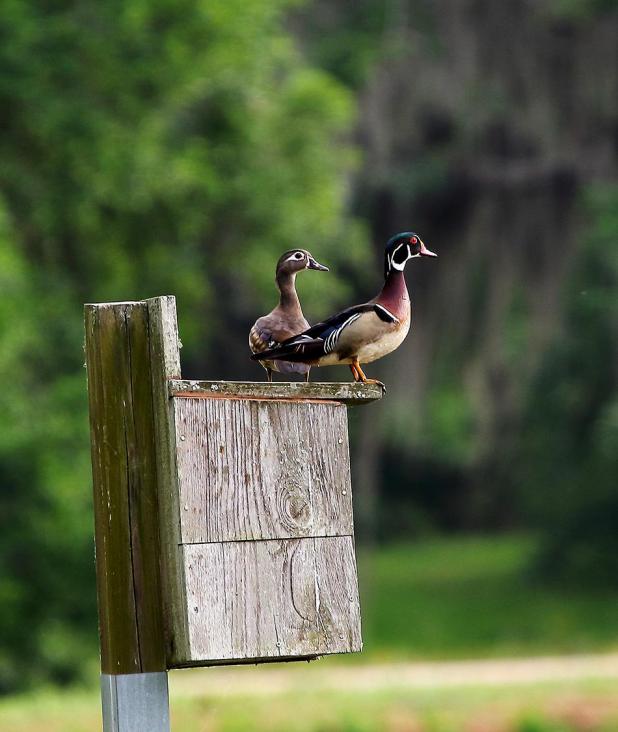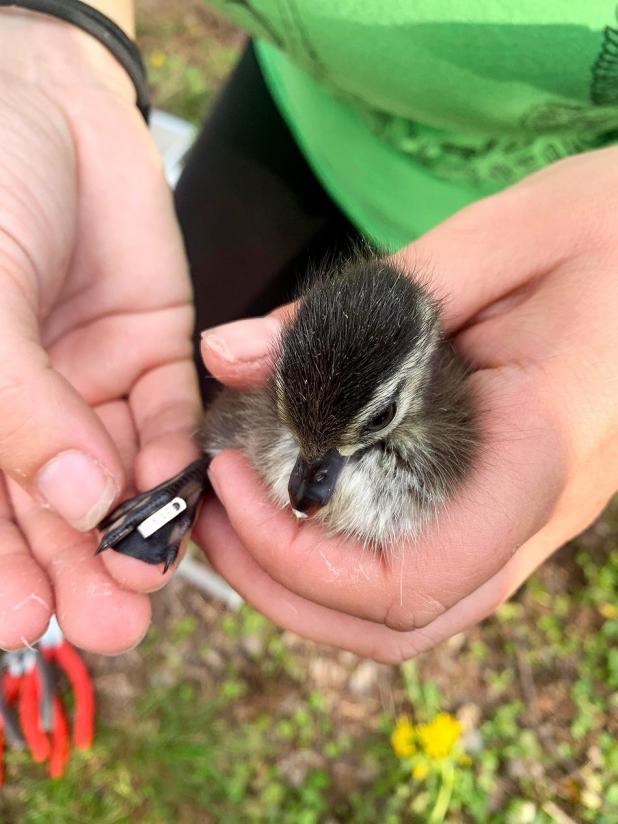
Wood Duck drake and hen, selecting a nest box.
—John Flores Photo

Wood Duck duckling with web tag foot.
—Nicole Bosco Photo
Wood duck nest box study underway
In a recent Louisiana Department of Wildlife and Fisheries press release, the department notified the public, particularly waterfowl hunters, of an ongoing population study of box nesting Wood Ducks.
Hunters and duck banders were asked to be on the lookout for banded Wood Duck hens and harvested or recaptured Wood Ducks with tags fixed to the web of their foot. Moreover, they were encouraged to be sure to report them to www.reportband.gov.
The Wood Duck is an iconic bird widely known for its beauty and has often been the subject of artistic work and a favorite of wildlife photographers. To hunters, the gaudy bird makes excellent table fare, and is often a favorite to drop off at the taxidermist.
During the late 1800s and early 1900s, Wood Duck populations plummeted to near extinction as a result of habitat loss, market meat hunting, and being killed for their plumes to decorate ladies’ hats.
The 1918 Migratory Bird Treaty Act prohibited and banned the hunting of Wood Ducks. Subsequently, Wood Duck populations started to rebound during the 1920s.
The first Wood Duck nesting box programs began in 1930s. Today, according to a Ducks Unlimited conservation article titled “Status of the Wood Duck,” it is estimated some 300,000 boxes exist in North America producing some 100,000 ducklings annually.
Wood Duck populations grew dramatically from the late ’50s through the late ’80s in both the Atlantic and Mississippi flyways. And, based on North American Breeding Surveys, continued to grow nationally from 1966 through 2015.
Second only to Mallards, Wood Ducks make up 10% of the national duck harvest each year, therefore making it an important bird to both waterfowl managers and hunters.
LDWF Waterfowl Program Manager Larry Reynolds says the department developed a Wood Duck nest box program in the mid-1990s, where the current Wood Duck study was conceived by the Nemours Wildlife Foundation and started in South Carolina in 2019.
Reynolds said, “Currently, the department maintains approximately 1,750 nest boxes, with a goal of 2,000. We’ve lost boxes in our program to storms, flooding, etc., that we are working to replace to get back to our goal number. However, we have never done a structured evaluation of the program. That has been on my long-term priority list for many years, primarily because of potential competition with expanding populations of Black-Belly Whistling Ducks, suggesting that parasitism and predation rates are high and duckling survival is poor.
“In fact,” Reynolds continued, “the big question of whether Wood Duck nest boxes contribute positively to populations in areas with sufficient nest cavities or are just a population ‘sink’ remains. That is the primary objective of this study.”
The second important objective of the study is Wood Duck recruitment. Essentially, biologists want to see if hens nesting in Wood Duck boxes produce hens that nest in Wood Duck boxes in future generations.
Reynolds says, by partnering with Dr. Kevin Ringelman, an assistant professor at the LSU School of Renewable Resources, who supervised a nest-box program at University of California, Davis, things really became interesting. Ringelman incorporated the use of PIT tags (Passive Integrated Transponders) in his studies that dramatically improved data, because of higher rates of returns compared to web tagging ducklings.
PIT tags are essentially the same type of microchip inserted in family pets such as dogs and cats. By scanning the chip, pets can be identified and returned to their owner.
Dylan Bakner is an LSU Graduate Research Assistant who works closely with Reynolds and as part of the study manages 310 of the LDWF’s nest boxes. A typical day in the field during the first eight months of the year keeps the grad-student busy.
Bakner, who is from Waynesboro, Penns-ylvania, and did his undergraduate studies at Penn State University, said, “Basically we have boxes we want to monitor on a weekly basis. So, pretty much, whatever box you did seven days ago, you’ll visit that day. When we come up to a box, we plug the hole and we take a peek inside to see if there is a hen sitting on a nest. Then we’ll capture the individual and take it out of the box and band them and put a PIT tag in them. We’ll take morphological measurements like the length, width and mass of the eggs and record how many there are and how far along they are in incubation.”
Bakner says during a day in the field after banding, PIT tagging hens and collecting nest data, they’ll switch efforts to capturing ducklings. By monitoring data, the technicians are able to home in on the expected hatch date. If their timing is right, the nest will be full of ducklings that they place web and PIT tags on.
Bakner said, “One thing interesting for Wood Ducks is we’re actually kind of doing 50-50 for each brood. If we have a nest of wood duck ducklings, we’re tagging half of them with web tags and half with PIT tags. The thought is we want to see how the recovery rates differ between the two things. One of the down sides to web tagging is that it’s thought a lot of them are not retained. So, a lot of these ducklings that have been webbed tagged, actually lose those tags.”
Bakner noted that when Black-Bellied Whistling Ducks and ducklings are encountered, all of them are PIT tagged as a way to learn anything they can about the species. Essentially, with an increasing population of Whistling Ducks in the southeastern United States and limited information on the species, it’s a way of obtaining data to better manage them in the future.
The Louisiana study is just a part of a national study of Wood Duck nest boxes being conducted and monitored by the Nemours Wildlife Foundation. Other southeastern states involved in the broad study include Mississippi, Florida, Georgia, North Carolina and South Carolina along with Maryland and Delaware in the northeast. Each field day’s work is uploaded into one large database managed by NWF.
One of the things Bakner has observed is mixed broods, where Wood Ducks will hatch Black-Bellied Whistling Ducks and vise-versa. And, more northerly nest boxes with Mergansers will hatch Wood Ducks and Wood Ducks Mergansers.
The study will continue through 2022 and will be compiled and reported to stakeholders once evaluated.
One final note. PIT tags are inserted along the bird’s spine towards the neck. Hunters who consume Wood Ducks are cautioned there is a remote possibility of finding a PIT tag when preparing a bird for consumption.
